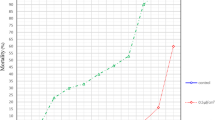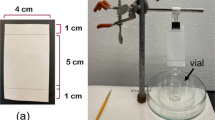Abstract
The toxicity of para-menthane-3,8-diol (PMD), the main arthropod-repellent compound in the oil of the lemon eucalyptus, Corymbia citriodora, was evaluated against nymphs of Ixodes ricinus using five methods (A–E) of a contact toxicity bioassay. Mortality rates were estimated by recording numbers of dead nymphs at 30 min intervals during the first 5 h after the start of exposure and at longer intervals thereafter. The mortality rate increased with increasing concentration of PMD and duration of exposure with a distinct effect after 3.5 h. From the results obtained by methods A, C and E, the LC50 range was 0.035–0.037 mg PMD/cm2 and the LC95 range was 0.095–0.097 mg PMD/cm2 at 4 h of exposure; the LT50 range was 2.1–2.8 h and the LT95 range was 3.9–4.2 h at 0.1 mg PMD/cm2. To determine the duration of toxic activity of PMD, different concentrations (0.002, 0.01, 0.1 mg PMD/cm2) were tested and mortality was recorded at each concentration after 1 h; thereafter new ticks were tested. This test revealed that the lethal activity of PMD remained for 24 h but appeared absent after 48 h. The overall results show that PMD is toxic to nymphs of I. ricinus and may be useful for tick control.







Similar content being viewed by others
References
Ahmed SM, Eapen M (1986) Vapour toxicity and repellency of some essential oils to insect pests. Indian Perfumer 30:273–278
Al-Rajhy DH, Alahmed AM, Hussein HI, Kheir SM (2003) Acaricidal effects of cardiac glycosides, azadirachtin and neem oil against the camel tick, Hyalomma dromedarii (Acari: Ixodidae). Pest Manag Sci 59:1250–1254
Bennet L, Halling A, Berglund J (2006) Increased incidence of Lyme borreliosis in southern Sweden following mild winters and during warm, humid summers. Eur Clin Microb Inf 25:426–432
Bormane A, Lucenko I, Duks A, Mavtchoutko V, Ranka R, Salmina K, Baumanis V (2004) Vectors of tick-borne diseases and epidemiological situation in Latvia in 1993–2002. Int J Med Microbiol 293(37):36–47
Choi W-I, Lee S-G, Park H-M, Ahn Y-J (2004) Toxicity of plant essential oils to Tetranychus urticae (Acari: Tetranychidae) and Phytoseiulus persimilis (Acari: Phytoseiidae). Econ Entomol 97:553–558
Curtis CF, Lines JD, Baolin L, Renz A (1991) Natural and synthetic repellents. In: Curtis CF (ed) Control of disease vectors in the community. Wolfe Publ. Ltd, London, pp 75–92
Daniel M, Danielova V, Kriz B, Jirsa A, Nozicka J (2003) Shift of the tick Ixodes ricinus and tick-borne encephalitis to higher altitudes in Central Europe. Eur J Clin Microbiol Inf Dis 22:327–328
Estrada-Peña A, Jongejan F (1999) Ticks feeding on humans: a review of records on human-biting Ixodoidea with special reference to pathogen transmission. Exp Appl Acarol 23:685–715
Gardulf A, Wohlfart I, Gustafson R (2004) A prospective cross-over field trial shows protection of lemon eucalyptus extract against tick bites. J Med Entomol 41:1064–1067
Garboui S, Pålsson K, Jaenson TGT (2006) Repellency of MyggA Natural® spray (para-menthane-3,8-diol) and RB86 (neem oil) against the tick Ixodes ricinus (L.) (Acari: Ixodidae) in the field in east-central Sweden. Exp Appl Acarol 40:271–277
Jaenson TGT, Garboui S, Pålsson K (2006) Repellency of the mosquito repellent MyggA Natural® (p-menthane-3,8-diol, PMD) to the common tick Ixodes ricinus (L.) (Acari: Ixodidae) in the laboratory and field. J Med Entomol 43:731–736
Jensen PM, Jespersen JB (2005) Five decades of tick-man interaction in Denmark: an analysis. Exp Appl Acarol 35:131–146
Kampen H, Rötzel DC, Kurtenbach K, Maier WA, Seitz HM (2004) Substantial rise in the prevalence of Lyme borreliosis spirochetes in a region of western Germany over a 10-year period. Appl Environm Microbiol 70:1576–1582
Kenmochi H, Akiyama T, Yuasa Y, Kobayashi T (2008) Method for producing para-menthane-3,8-diol. United States Patent 5959161. 13 pp. [Online] http://freepatentsonline.com/5959161.html. Last access: 11/12/2008
Lindgren E, Gustafson R (2001) Tick-borne encephalitis in Sweden and climate change. Lancet 358:16–18
Lindgren E, Jaenson TGT (2006) Lyme borreliosis in Europe: influences of climate and climate change, epidemiology, ecology and adaptation measures. In: Menne B, Ebi KL (eds) Climate change and adaptation strategies for human health. Steinkopf Verlag, Darmstadt & World Health Organization, Geneva, pp 157–188
Lindgren E, Tälleklint L, Polfeldt T (2000) Impact of climatic change on the northern distribution limit and population density of the disease-transmitting European tick Ixodes ricinus. Environm Health Persp 108:119–123
Materna J, Daniel M, Danielova V (2005) Altitudinal distribution limit of the tick Ixodes ricinus shifted considerably towards higher altitudes in Central Europe: Results of three years monitoring in the Krkonos Mts. (Czech Republic). Centr Eur J Publ Health 13:24–28
Mejlon HA, Jaenson TGT (1993) Seasonal prevalence of Borrelia burgdorferi in Ixodes ricinus in different vegetation types in Sweden. J Med Entomol 42:352–358
WHO (1996) Pesticides evaluation scheme. Report of the WHO Informal Consultation on the Evaluation and Testing of Insecticides. CTD/WHOPES/IC/96.1. 45 pp. Division for Control of Tropical Diseases, World Health Organization, Geneva
Piesman J (1993) Dynamics of Borrelia burgdorferi transmission by nymphal Ixodes dammini ticks. J Infect Dis 167:1082–1085
Sarih MH, Jouda F, Gern L, Postic D (2003) First isolation of Borrelia burgdorferi sensu lato from Ixodes ricinus ticks in Morocco. Vector-Borne Zoon Dis 3:133–139
Silva-Aguayo G (2004) Pesticides: Chemistry/Pesticide Resistance. Botanical Insecticides (on line). In: Ware GW, Whitacre DM (eds) Radcliffe’s IPM world textbook. An introduction to insecticides, 4th edn. Meister Pro Information Resources. A Division of Meister Media Worldwide, University of Minnesota, Willoughby
Sonenshine DE (2003) Ticks. In: Vincent HR, Ring TC (eds) Encyclopaedia of insects. Old Dominion University, Elsevier Science, USA, p 1132
Strickman D (2006) PMD (p-menthane-3,8-diol) and quwenling. In: Debboun M, Frances SP, Strickman D (eds) Insect repellents. Principles, methods and uses. CRC Press, Boca Raton, pp 347–351
Tälleklint L, Jaenson TGT (1998) Increasing geographical distribution and density of Ixodes ricinus (Acari: Ixodidae) in central and northern Sweden. J Med Entomol 35:521–526
Yeh MT, Bak J, Hu R, Nicholson MC, Kelly C, Mather TN (1995) Determining the duration of Ixodes scapularis (Acari: Ixodidae) attachment to tick-bite victims. J Med Entomol 32:853–858
Zhioua E, Heyer K, Browning M, Ginsberg HS, LeBrun RA (1999) Pathogenicity of Bacillus thuringiensis variety kurstaki to Ixodes scapularis (Acari: Ixodidae). J Med Entomol 36:900–902
Acknowledgments
We are grateful to the Libyan Embassy, Stockholm; Bioglan Pharma–Max Medica, Malmö, Sweden; The Swedish Research Council for Environment, Agricultural Sciences and Spatial Planning (Formas/SJFR); and The Swedish International Development Co-operation Agency (Sida/Sarec) for funding this work.
Author information
Authors and Affiliations
Corresponding author
Rights and permissions
About this article
Cite this article
Elmhalli, F.H., Pålsson, K., Örberg, J. et al. Acaricidal effects of Corymbia citriodora oil containing para-menthane-3,8-diol against nymphs of Ixodes ricinus (Acari: Ixodidae). Exp Appl Acarol 48, 251–262 (2009). https://doi.org/10.1007/s10493-009-9236-4
Received:
Accepted:
Published:
Issue Date:
DOI: https://doi.org/10.1007/s10493-009-9236-4




